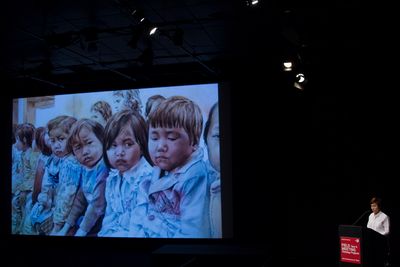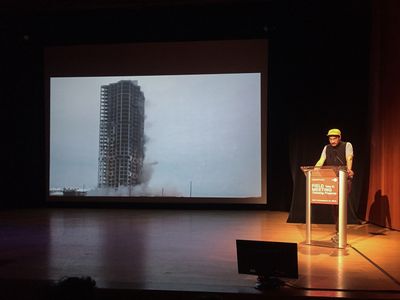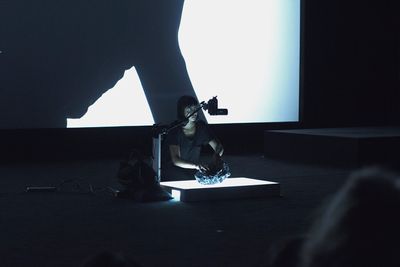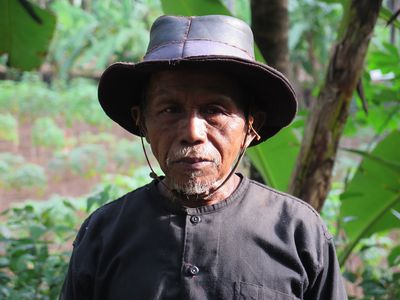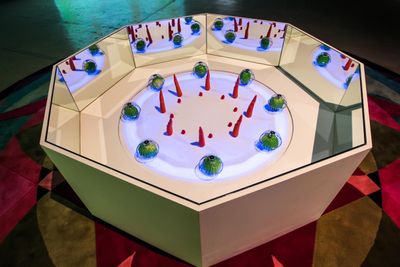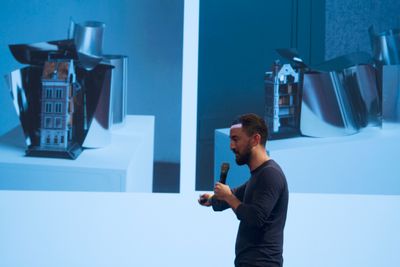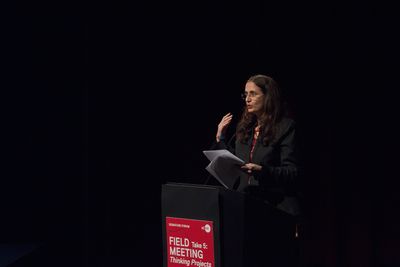ACAW FIELD MEETING Take 5: Thinking Projects
Asia Contemporary Art Week's FIELD MEETING Take 5: Thinking Projects (14–15 October 2017). Discussion hosted at SVA Theatre, with (from left to right): Boon Hui Tan, Marat Raiymkulov, Simon Fujiwara, Taus Makhacheva, Xiaoyu Weng.
'Be a dreamer, not a screamer'. So urged Vietnam-based artist Tiffany Chung as she re-mapped the movements of refugees across national fault lines in her lecture-performance for FIELD MEETING Take 5: Thinking Projects, the fifth iteration of Asia Contemporary Art Week's (ACAW) annual signature forum in New York (14–15 October 2017), this year hosted by Asia Society and SVA Theatre. Chung advocated for the visual narration of political issues that might offer alternative—and more honest—portrayals than those put forward by dominant, mainstream ideologies. When asked to illustrate her point further, Chung urged artists to make their art 'useful'—a position that resonated with an audience feeling the renewed urgency of activism given the current political climate in the United States.
With a roster of 25 artists, scientists, scholars and curators participating in the two-day forum, including Laura Barlow, art historian and curator at Mathaf: Arab Museum of Modern Art (Doha), music producer Junod Etienne and artists Dai Guangyu and Abdullah M.I. Syed, Chung's motto captured the tenor of this year's FIELD MEETING as a whole. Presented in a format that 'emulates the experience of a studio visit on a larger, communal scale', to quote curator and ACAW director Leeza Ahmady, the meeting's overarching theme—'thinking projects'—called for the overcoming of divisions, be it between centre and periphery, man and nature, or between disciplines and understandings. The meeting consisted of six sessions, each followed by a panel discussion. The first day included remarks and presentations that situated the role of art and culture within increasingly destabilised national and religious borders, and explored 'projects' as a form of resistance. The second day explored art history from a lateral perspective by bringing forgotten, unexplored or marginalised artists—as well as art historical moments—to the centre.
While bringing Asian practitioners from the 'periphery' to the 'centre' remains a consistent feature of ACAW's signature forum, this year's iteration built upon its previous rejections of Euro-American-centric triumphalism. Many practitioners chose not to engage with a decentring rhetoric, choosing to directly enact a protagonistic voice rather than a subaltern one by focusing on personal experiences. New York-based writer and e-flux journal editor Brian Kuan Wood's lecture-novella, The Story of Peter Green Peter Chang, recounted the life of 'a friend of a friend'—an architect and entrepreneur who constantly traversed between his Chinese legacy and American present, and between commercial imperative and artistic self. Narrated in a hypnotically nonchalant voice, with a projection showing the same highrise building collapsing over and over again in the background, the piece connected even the most static members of the audience to the mindset of a peripatetic 'other', defined by the state of permanently swinging between either/and/or without settlement. (This unresolved and elliptical sensation of otherness was invoked in other presentations, too, including Suhanya Raffel's introduction to M+, a museum in the transitional city of Hong Kong scheduled to open in 2019.)
In a number of presentations, speakers engaged with the politicisation of experience itself, with memories obtaining an insurgent edge. Marat Raiymkulov, a Bishkek-based professor of physics and founder of the art collective 705, spontaneously changed his presentation the night before he was due to speak, taking the intimacy of FIELD MEETING further into a realm of partial indecipherability. He presented a monologue of his intellectual life in the capital of Kyrgyzstan against a series of drawing projections he created on slides that have fallen out of use in the States.
Some artists chose to incise into personal histories through the perspective of gender. For Hold Everything Dear, Montréal-based Hajra Waheed sat in the centre of a darkened stage gesturing around an ambiguously formed rock-like substance upon an old-fashioned projector, while her gestures were projected as a shadow play onto a large screen in the background. (A woman's voice spoke over the action, recounting the experience of being female in the world.) The piece, disarming in its intimacy but enigmatic in its poetry, made viewers feel at once excluded from a personal world while also being invited into it—a tension that permeated FIELD MEETING Take 5 as a whole in terms of how it mediated the various positions expressed throughout.
Both Hong Kong-based Hera Chan and Makhachkala/Moscow-based Taus Makhacheva departed from the ownership of sexuality or corporeality under oppressive conditions (and the lack thereof), be it a consumer society or totalitarian regime. Everyday objects (lollipops and cutlery in Makhacheva's case) and human bodies (contestants for pageantry in Chan's) became conduits for ruminations on the larger system within which these objects/subjects are ensconced—a criticism that became especially sharp in Yogyakarta-based artist and educator Nadiah Bamadhaj's presentation, A King in a Republic. For this lecture-performance, Bamadhaj delivered a critique of Yogyakarta's unique political situation while showcasing a video of Bamadhaj holding a microphone to the mouths of sculptures around the Royal Palace of Yogyakarta in the form of a pseudo-interview. (The 'responses' from interviewees were translated and presented in the film as English subtitles—as if these 'palace courtiers', as Bamadhaj called them, had become silenced witnesses of the historical atrocities they recalled.)
Bamadhaj's video was bitingly funny, with the artist's accompanying lecture offering a brave critique of political domination. A self-assured intellectual who has been living in the monarchic district for 15 years with her husband and son, Bamadhaj referred to Sri Sultan Hamengkubuwono X as the 'unelected representative of a democratic republic'. (Such utterances risk persecution in her home country, and Bamadhaj kept the content of the entire lecture-performance, created for FIELD MEETING, secret—even from her husband—during her preparations.) 'For hundreds of years land was used and structured to critically imprint Yogyakarta's royal dominance', said Bamadhaj, as the screen showed a mountainous island gridded with boundary markers. Bamadhaj filmed her gruelling ascent of the 345 steps to the royal cemeteries of the Mataram kings: 'the only true way for commoners to access the cemeteries'. The artist regards such mechanisms of keeping people obedient and silent without overt violence as 'subliminal coercion'—'in itself a spectacular phenomenon deserving artistic introspection'.
The forum took an eco-cosmological turn in the presentations of artists and scientists Adrian Wong, Kingsley Ng, Bruce Quek and Marwa Arsanios. Topics ranged from the disappearance of stars in the night sky (Quek) and the loss of contact between humans and nature (Arsanios), to alternative ways of inhabiting the cityscape, either by activating the 'qi' (life force) through acupuncture theory (Ng) or by collaborating with the likes of Feng Shui masters, geomancers and telepathic animal communicators (Wong).
If these ideas sound daring, the audience was carried away even more by Taiwan-based Yin-Ju Chen's lecture-performance Extrastellar Evaluations. Using a series of images in a slideshow, the artist narrated her expedition to California's Mt. Shasta in search of a lost civilisation called 'Lemuria', only to discover that the ancient, alien Lemurians were not only still in existence, but were trying to communicate with our world (the third dimension). In a striking slide, Chen mapped the history of the American Conceptual art movement as a field of communicative codes from the Lemurians—strangely convincing in visual terms, as Minimalist works and Land Art lend themselves well to the idea of sublimated spiritual messages. Chen appeared utterly serious and convincing in her presentation, until the content became more and more ludicrous, and it dawned on the audience that the artist was acting.
The forum ended with heated debates ignited by a keynote lecture by Berlin-based, London-born artist Simon Fujiwara: Hope House—A Guided Tour. Fujiwara talked about an installation he created in 2017, which consists of a full-scale replica of the Anne Frank House currently on view as a building within a building across four floors of Tel Aviv's Dvir Gallery (Hope House, 2 September–2 December 2017). In contrast to How Not to be a Footnote to Western Art History, a keynote lecture mapping out the life and work of Indian artist Navjot Altaf by Bombay-based cultural theorist and curator Nancy Adajania, Fujiwara did not concern himself with the problem of who owned the right to narrate a certain history, and through what means. Instead, as he explained, he chose to implicate the Anne Frank House within the machinery of capitalism, peppering his replica with markers of commerce and political oppression, such as an outfit from Topshop Unique that Beyoncé wore on her visit to the House, and tickets to the Apartheid museum in South Africa.
Fujiwara confessed that he had doubts about the project, as he is not a woman and did not experience the Holocaust—but still he finished it under his gallerist's encouragement. During the discussion that followed the talk, the morality of Fujiwara's installation was subject to examination, during which one audience member confronted the artist about the lack of any mention of the apartheid-like segregation in Israel, happening right on the site of the installation. Fujiwara responded by defending his right to choose the political topic that he felt the need to address, while another audience member, visibly shaken, pointed to the complicit aspect of the installation in the very capitalistic machinery he aimed to critique. The debate remained unresolved until its conclusion, when curator Leeza Ahmady took to stage and urged everyone to 'take a deep breath'. (An intervention that highlighted the sense of chaos that permeated the meeting as a whole.)
Such polemicism, not often seen in forums nowadays, presented a rare glimpse into the many dilemmas, moral or otherwise, that creative practitioners face in a world with greater access to different cultures and histories, yet with mounting difficulties when it comes to truly understanding them. In the case of Fujiwara's lecture, though the artist was aware that he did not 'own' the experience commemorated by the Anne Frank House, or that of the context whch surrounds it, he certainly owned the capitalistic experience that he wanted to expose through his intervention. Did the audience challenge Fujiwara because of a perceived facileness with which he approached both the Anne Frank House and—to a certain extent—the capitalist mechanisms he associated with it? After all, Fujiwara suggested that the House posted a message on Facebook left in the guestbook by Justin Bieber—in which he hoped that Anne Frank 'would have been a belieber'—to boost the House's popularity among younger generations. He did not discuss the House's graceful response to Bieber, nor did he raise the possibility that the House was acting out of a responsibility to engage the public with the problem of handling Anne Frank's legacy today. Although his aim was not to present every argument like a research project, the simplicity of his departure profoundly irked some in the audience—no doubt a reflection, too, on recent discussions surrounding questions of victimhood and voice, and the anger that is invoked when artists choose to deal with the experiences of others.
Though art history from the periphery has been a recurrent theme and function of FIELD MEETING, and this year's iteration was graced by artists from Kazakhstan to Qatar, the issue of who owns the right to narrate the world's histories—and how—is clearly still up for debate. At the same time, these debates are at risk of being formulated, if not congealed, into a new form of censorship, whereby the language of ownership increasingly coincides with that of silencing.–[O]

